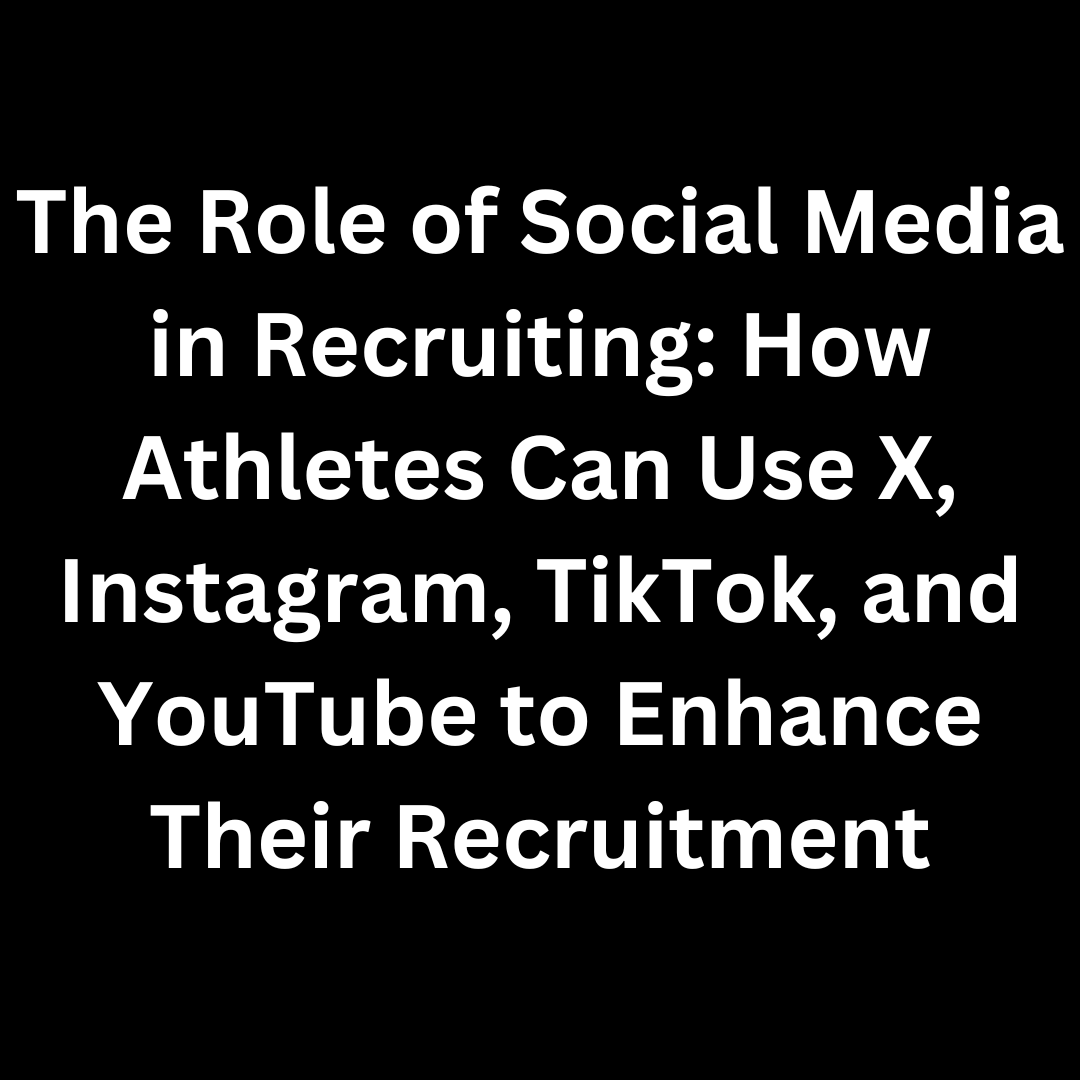In today's digital age, social media has become a powerful tool in the recruiting process for athletes. College coaches and recruiters are increasingly turning to platforms like X (formerly Twitter), Instagram, TikTok, and YouTube to scout potential athletes and gain insights into their character, work ethic, and personal brand. For athletes looking to stand out in the crowded recruiting landscape, using social media effectively can significantly boost visibility and enhance their chances of getting noticed by coaches. This article explores the role of social media in recruiting and provides practical tips for athletes on how to leverage these platforms to maximize their exposure.
Why Social Media Matters in Recruiting
Social media has changed the way recruiting works by providing coaches with instant access to an athlete's highlights, personality, and daily routines. Here’s why it has become so essential:
1. Increased Visibility
Social media allows athletes to showcase their skills to a broad audience, including coaches, scouts, and recruiters, without having to rely on traditional channels. Platforms like Instagram and TikTok make it easy to post highlights, training routines, and achievements in real-time, helping athletes stay on the radar of college programs.
2. Direct Communication
Social media provides athletes with a direct line of communication to college coaches. Platforms like X (formerly Twitter) are frequently used by coaches to communicate with recruits, respond to highlights, or share scholarship opportunities. For athletes, this offers a chance to engage directly with the programs they’re interested in.
3. Showcase Your Personality
Recruiters aren’t just looking for talented athletes—they’re looking for team players who fit the culture of their program. Social media allows athletes to showcase their personality, work ethic, leadership, and values, giving coaches a more complete picture of who they are off the field.
4. Real-Time Updates
Social media allows athletes to update coaches and recruiters on their progress in real-time, whether it’s through highlight videos, personal records, or academic achievements. This constant engagement can help keep you top of mind for coaches who are recruiting for specific positions.
Best Social Media Platforms for Athletes
Different platforms serve different purposes in the recruiting process, and knowing how to use each one strategically can give athletes an edge. Here’s a breakdown of the top social media platforms and how to use them for recruiting:
1. X (Formerly Twitter): Real-Time Engagement and Direct Communication
X is one of the most popular platforms used by college coaches for recruiting. It allows athletes to share quick updates, tag coaches, and engage in real-time with their followers.
- Post Regular Updates: Share game highlights, stats, and achievements after each game or competition. This gives coaches a sense of your consistent performance.
- Tag Coaches and Programs: If you post a highlight or an important achievement, tag the schools and coaches you’re interested in. Many coaches actively monitor X for recruiting purposes.
- Use Hashtags: Using sport-specific hashtags like #BasketballRecruiting or #FootballProspect can increase the chances of your posts being seen by recruiters.
- Engage with Coaches: Retweet or reply to posts from coaches and programs you're interested in. This helps you stay on their radar and shows you're following their teams.
2. Instagram: Visual Storytelling Through Photos and Videos
Instagram is ideal for showcasing your athletic journey through photos, videos, and stories. It’s a great platform to share more in-depth content and build a personal brand that coaches can follow.
- Post Highlight Reels: Create short highlight reels of your best plays and post them on your feed. Use the Instagram Stories feature to share game-day moments, behind-the-scenes training, or even academic achievements.
- Showcase Your Work Ethic: Instagram is not just about game highlights—coaches want to see how hard you work behind the scenes. Post content about your training regimen, workouts, or recovery routines to demonstrate your dedication.
- Leverage Instagram Stories: Use the "Stories" feature to share updates that might not warrant a permanent post. Whether it's training updates, motivational quotes, or a look into your daily routine, Instagram Stories allow you to stay active and engaged with your audience.
- Use Relevant Hashtags: Include sport-specific hashtags and tag colleges or coaches in your posts to increase visibility.
3. TikTok: Creativity Meets Athleticism
TikTok’s short-form, engaging content allows athletes to showcase their skills in a creative and attention-grabbing way. It’s a fun platform that enables you to show off your personality while also highlighting your athletic abilities.
- Create Skill-Based Videos: Post short videos of specific skills or drills that set you apart. Whether it’s a trick shot, impressive footwork, or a speed drill, creative content can attract a lot of attention.
- Follow Trends: Incorporating popular TikTok trends or challenges into your athletic content can increase engagement and help you reach a wider audience. For example, participate in fitness challenges that align with your sport.
- Engage with Fellow Athletes and Coaches: Follow other athletes and coaches, and engage with their content by liking, commenting, or duetting their videos. This can help you build a network within the athletic community.
- Show Your Personality: While TikTok is a great place to showcase your athleticism, it’s also a platform to show your personality, sense of humor, and unique style. Coaches appreciate athletes who are relatable and fun to watch.
4. YouTube: Long-Form Content and Detailed Highlights
YouTube is the best platform for long-form content and detailed highlight reels. Coaches often use YouTube to get a comprehensive look at an athlete’s abilities over a longer period, making it a valuable tool for recruitment.
- Create Highlight Reels: YouTube is the ideal platform for posting extended highlight reels that showcase a full season’s worth of performance or specific skills you’ve developed.
- Organize Playlists: Create playlists of different games, seasons, or types of skills (e.g., offense, defense, speed drills) so coaches can easily navigate through your content.
- Tutorials and Training Videos: Consider posting videos that explain your training process or break down your performance. For example, you could upload videos of your weight training routines, conditioning exercises, or game preparation.
- Use Descriptive Titles and Tags: Be sure to use clear, descriptive titles and tags in your videos so coaches can easily find them. Include keywords like “2025 Football Recruit Highlights” or “Basketball Shooting Drill.”
Best Practices for Using Social Media in Recruiting
While social media is a powerful tool for recruiting, it can also be a double-edged sword. Athletes must be mindful of how they present themselves online, as college coaches will evaluate not only their athletic skills but also their behavior and professionalism. Here are some best practices for using social media in the recruiting process:
1. Keep It Professional
Your social media profiles should reflect the image of someone ready to compete at the collegiate level. Avoid posting anything that could be considered controversial or inappropriate. Coaches will often do a background check on athletes’ social media profiles, so it’s crucial to maintain a professional and positive presence.
2. Be Authentic
While it's important to be professional, it's equally important to be authentic. Coaches want to recruit athletes who are genuine and have strong character. Show who you are off the field—your interests, hobbies, and how you handle challenges.
3. Consistency Is Key
Posting regularly is essential to staying on the radar of coaches and programs. Consistently update your profiles with new highlights, training videos, and achievements. This shows that you’re actively working to improve and are dedicated to your sport.
4. Engage with the Right People
Follow and engage with college programs, coaches, and other athletes in your sport. Commenting on and sharing relevant content can help you build connections and get noticed by people who can influence your recruiting process.
5. Monitor Your Followers and Comments
Make sure you’re aware of who’s following you and what’s being said in your comments. Negativity, even if it’s not coming from you, can reflect poorly on your profile. Stay in control of your social media presence by managing comments and followers carefully.
In the modern recruiting landscape, social media plays a crucial role in helping athletes connect with college coaches and showcase their talents. By using platforms like X, Instagram, TikTok, and YouTube effectively, athletes can increase their visibility, communicate directly with recruiters, and build a strong personal brand that sets them apart.
Remember, social media is a powerful tool, but it’s essential to use it wisely. Keep your profiles professional, post consistently, and engage authentically with your audience. With the right strategy, you can turn your social media presence into a key asset in your recruiting journey.

